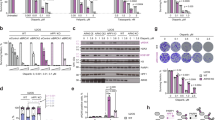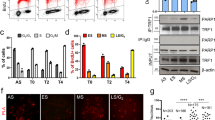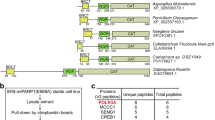Abstract
The transcription factor adenovirus E2 promoter-binding factor (E2F)-1 normally enhances cell-cycle progression, but it also induces apoptosis under certain conditions, including DNA damage and serum deprivation. Although DNA damage facilitates the phosphorylation and stabilization of E2F1 to trigger apoptosis, how serum starvation renders cells vulnerable to E2F1-induced apoptosis remains unclear. Because poly(ADP-ribose) polymerase 1 (PARP1), a nuclear enzyme essential for genomic stability and chromatin remodeling, interacts directly with E2F1, we investigated the effects of PARP1 on E2F1-mediated functions in the presence and absence of serum. PARP1 attenuation, which increased E2F1 transactivation, induced G2/M cell-cycle arrest under normal growth conditions, but enhanced E2F1-induced apoptosis in serum-starved cells. Interestingly, basal PARP1 activity was sufficient to modify E2F1 by poly(ADP-ribosyl)ation, which stabilized the interaction between E2F1 and the BIN1 tumor suppressor in the nucleus. Accordingly, BIN1 acted as an RB1-independent E2F1 corepressor. Because E2F1 directly activates the BIN1 gene promoter, BIN1 curbed E2F1 activity through a negative-feedback mechanism. Conversely, when the BIN1–E2F1 interaction was abolished by PARP1 suppression, E2F1 continuously increased BIN1 levels. This is functionally germane, as PARP1-depletion-associated G2/M arrest was reversed by the transfection of BIN1 siRNA. Moreover, PARP-inhibitor-associated anti-transformation activity was compromised by the coexpression of dominant-negative BIN1. Because serum starvation massively reduced the E2F1 poly(ADP-ribosyl)ation, we conclude that the release of BIN1 from hypo-poly(ADP-ribosyl)ated E2F1 is a mechanism by which serum starvation promotes E2F1-induced apoptosis.
Similar content being viewed by others
Log in or create a free account to read this content
Gain free access to this article, as well as selected content from this journal and more on nature.com
or
Abbreviations
- E2F:
-
adenovirus E2 promoter-binding factor
- PARP1:
-
poly(adenosine diphosphate [ADP]-ribose) polymerase 1
- PAR:
-
poly(ADP-ribose) polymer chain
- BIN1:
-
bridging integrator 1
- BAR:
-
BIN-Amphiphysin-Rvs homology domain
- MBD:
-
MYC-binding domain
- SH3:
-
src homology domain 3
- MB:
-
marked box domain
- TA:
-
transactivation domain
- ER:
-
estrogen receptor
- GST:
-
glutathione-S-transferase
- HA:
-
hemagglutinin
- DAPI:
-
4′,6-diamidino-2-phenylindole
- 4-OHT:
-
4-hydroxy tamoxifen
- sh-/si-RNA:
-
short hairpin-/small interfering-RNA
- ChIP:
-
chromatin immunoprecipitation
- Luc:
-
luciferase-reporter vector
- qRT-PCR:
-
quantitative reverse transcriptase-polymerase chain reaction
- MEFs:
-
mouse embryonic fibroblasts
References
Guo XE, Ngo B, Modrek AS, Lee WH . Targeting tumor suppressor networks for cancer therapeutics. Curr Drug Targets 2014; 15: 2–16.
Orr B, Compton DA . A double-edged sword: how oncogenes and tumor suppressor genes can contribute to chromosomal instability. Front Oncol 2013; 3: 164.
Hanel W, Moll UM . Links between mutant p53 and genomic instability. J Cell Biochem 2012; 113: 433–439.
Moody CA, Laimins LA . Human papillomavirus oncoproteins: pathways to transformation. Nat Rev Cancer 2010; 10: 550–560.
Polager S, Ginsberg D . p53 and E2f: partners in life and death. Nat Rev Cancer 2009; 9: 738–748.
Johnson DG, Degregori J . Putting the oncogenic and tumor suppressive activities of E2F into context. Curr Mol Med 2006; 6: 731–738.
Stanelle J, Pützer BM . E2F1-induced apoptosis: turning killers into therapeutics. Trends Mol Med 2006; 12: 177–185.
Moroni MC, Hickman ES, Lazzerini Denchi E, Caprara G, Colli E, Cecconi F et al. Apaf-1 is a transcriptional target for E2F and p53. Nat Cell Biol 2001; 3: 552–558.
Furukawa Y, Nishimura N, Furukawa Y, Satoh M, Endo H, Iwase S et al. Apaf-1 is a mediator of E2F-1-induced apoptosis. J Biol Chem 2002; 277: 39760–39768.
Nahle Z, Polakoff J, Davuluri RV, McCurrach ME, Jacobson MD, Narita M et al. Direct coupling of the cell cycle and cell death machinery by E2F. Nat Cell Biol 2002; 4: 859–864.
Komori H, Enomoto M, Nakamura M, Iwanaga R, Ohtani K . Distinct E2F-mediated transcriptional program regulates p14ARF gene expression. EMBO J 2005; 24: 3724–3736.
del Arroyo AG, El Messaoudi S, Clark PA, James M, Stott F, Bracken A et al. E2F-dependent induction of p14ARF during cell cycle re-entry in human T cells. Cell Cycle 2007; 6: 2697–2705.
Stiewe T, Pützer BM . Role of the p53-homologue p73 in E2F1-induced apoptosis. Nat Genet 2000; 26: 464–469.
Cassimere EK, Pyndiah S, Sakamuro D . The c-MYC-interacting proapoptotic tumor suppressor BIN1 is a transcriptional target for E2F1 in response to DNA damage. Cell Death Differ 2009; 16: 1641–1653.
Kinney EL, Tanida S, Rodrigue AA, Johnson JK, Tompkins VS, Sakamuro D . Adenovirus E1A oncoprotein liberates c-Myc activity to promote cell proliferation through abating Bin1 expression via an Rb/E2F1-dependent mechanism. J Cell Physiol 2008; 216: 621–631.
Yamasaki L, Jacks T, Bronson R, Goillot E, Harlow E, Dyson NJ . Tumor induction and tissue atrophy in mice lacking E2F-1. Cell 1996; 85: 537–548.
Field SJ, Tsai FY, Kuo F, Zubiaga AM, Kaelin Jr WG, Livingston DM et al. E2F-1 functions in mice to promote apoptosis and suppress proliferation. Cell 1996; 85: 549–561.
Dick FA, Rubin SM . Molecular mechanisms underlying RB protein function. Nat Rev Mol Cell Biol 2013; 14: 297–306.
Di Fiore R, D'Anneo A, Tesoriere G, Vento R . RB1 in cancer: different mechanisms of RB1 inactivation and alterations of pRb pathway in tumorigenesis. J Cell Physiol 2013; 228: 1676–1687.
Gibson BA, Kraus WL . New insights into the molecular and cellular functions of poly(ADP-ribose) and PARPs. Nat Rev Mol Cell Biol 2012; 13: 411–424.
Luo X, Kraus WL . On PAR with PARP: cellular stress signaling through poly(ADP-ribose) and PARP-1. Gene Dev 2012; 26: 417–432.
Ji Y, Tulin AV . The roles of PARP1 in gene control and cell differentiation. Curr Opin Genet Dev 2010; 20: 512–518.
Kummar S, Chen A, Parchment RE, Kinders RJ, Ji J, Tomaszewski JE et al. Advances in using PARP inhibitors to treat cancer. BMC Med 2012; 10: 25.
Simbulan-Rosenthal CM, Rosenthal DS, Luo R, Samara R, Espinoza LA, Hassa PO et al. PARP-1 binds E2F-1 independently of its DNA binding and catalytic domains, and acts as a novel coactivator of E2F-1-mediated transcription during re-entry of quiescent cells into S phase. Oncogene 2003; 22: 8460–8471.
Dantzer F, de La Rubia G, Ménissier-De Murcia J, Hostomsky Z, de Murcia G, Schreiber V . Base excision repair is impaired in mammalian cells lacking Poly(ADP-ribose) polymerase-1. Biochemistry 2000; 39: 7559–7569.
Kovesdi I, Reichel R, Nevins JR . Role of an adenovirus E2 promoter binding factor in E1A-mediated coordinate gene control. Proc Natl Acad Sci USA 1987; 84: 2180–2184.
Pyndiah S, Tanida S, Ahmed KM, Cassimere EK, Choe C, Sakamuro D . c-MYC suppresses BIN1 to release poly(ADP-ribose) polymerase 1: a mechanism by which cancer cells acquire cisplatin resistance. Sci Signal 2011; 4: ra19.
Chiou SH, Jiang BH, Yu YL, Chou SJ, Tsai PH, Chang WC et al. Poly(ADP-ribose) polymerase 1 regulates nuclear reprogramming and promotes iPSC generation without c-Myc. J Exp Med. 2013; 210: 85–98.
Sakamuro D, Elliott KJ, Wechsler-Reya R, Prendergast GC . BIN1 is a novel MYC-interacting protein with features of a tumour suppressor. Nat Genet 1996; 14: 69–77.
Elliott K, Sakamuro D, Basu A, Du W, Wunner W, Staller P et al. Bin1 functionally interacts with Myc and inhibits cell proliferation via multiple mechanisms. Oncogene 1999; 18: 3564–3573.
Lundgaard GL, Daniels NE, Pyndiah S, Cassimere EK, Ahmed KM, Rodrigue A et al. Identification of a novel effector domain of BIN1 for cancer suppression. J Cell Biochem 2011; 112: 2992–3001.
Yelamos J, Farres J, Llacuna L, Ampurdanes C, Martin-Caballero J . PARP-1 and PARP-2: New players in tumour development. Am J Cancer Res 2011; 1: 328–346.
Szántó M, Brunyánszki A, Kiss B, Nagy L, Gergely P, Virág L et al. Poly(ADP-ribose) polymerase-2: emerging transcriptional roles of a DNA-repair protein. Cell Mol Life Sci 69: 4079–4092 2012.
Murai J, Huang SY, Das BB, Renaud A, Zhang Y, Doroshow JH et al. Trapping of PARP1 and PARP2 by clinical PARP inhibitors. Cancer Res 2012; 72: 5588–5599.
DuHadaway JB, Sakamuro D, Ewert DL, Prendergast GC . Bin1 mediates apoptosis by c-Myc in transformed primary cells. Cancer Res 2001; 61: 3151–3156.
Elliott K, Ge K, Du W, Prendergast GC . The c-Myc-interacting adaptor protein Bin1 activates a caspase-independent cell death program. Oncogene 2000; 19: 4669–4684.
Casal E, Federici L, Zhang W, Fernandez-Recio J, Priego EM, Miguel RN et al. The crystal structure of the BAR domain from human Bin1/amphiphysin II and its implications for molecular recognition. Biochemistry 2006; 45: 12917–12928.
Arnold K, Bordoli L, Kopp J, Schwede T . The SWISS-MODEL Workspace: A web-based environment for protein structure homology modelling. Bioinformatics 2006; 22: 195–201.
Kelley LA, Sternberg MJE . Protein structure prediction on the web: a case study using the Phyre server. Nat Protocol 2009; 4: 363–371.
Ge K, DuHadaway J, Du W, Herlyn M, Rodeck U, Prendergast GC . Mechanism for elimination of a tumor suppressor: aberrant splicing of a brain-specific exon causes loss of function of Bin1 in melanoma. Proc Natl Acad Sci USA 1999; 96: 9689–9694.
Ge K, Duhadaway J, Sakamuro D, Wechsler-Reya R, Reynolds C, Prendergast GC . Losses of the tumor suppressor BIN1 in breast carcinoma are frequent and reflect deficits in programmed cell death capacity. Int J Cancer 2000; 85: 376–383.
Ge K, Minhas F, Duhadaway J, Mao N-C, Wilson D, Buccafusca R et al. Loss of heterozygosity and tumor suppressor activity of Bin1 in prostate carcinoma. Int J Cancer 2000; 86: 155–161.
Ghaneie A, Zemba-Palko V, Itoh H, Itoh K, Sakamuro D, Nakamura S et al. Bin1 attenuation in breast cancer is correlated to nodal metastasis and reduced survival. Cancer Biol Ther 2007; 6: 192–194.
Chang MY, Boulden J, Sutanto-Ward E, Duhadaway JB, Soler AP, Muller AJ et al. Bin1 ablation in mammary gland delays tissue remodeling and drives cancer progression. Cancer Res 2007a; 67: 100–107.
Chang MY, Boulden J, Katz B, Wang L, Meyer TJ, Soler AP et al. Bin1 ablation increases susceptibility to cancer during aging, particularly lung cancer. Cancer Res 2007b; 67: 7605–7612.
Prendergast GC, Muller AJ, Ramalingam A, Chang MY . BAR the door: cancer suppression by amphiphysin-like genes. Biochim Biophys Acta 2009; 1795: 25–36.
Prokic I, Cowling BS, Laporte J . Amphiphysin 2 (BIN1) in physiology and diseases. J Mol Med (Berl) 2014; 92: 453–463.
Kingwell K . Alzheimer disease: BIN1 variant increases risk of Alzheimer disease through tau. Nat Rev Neurol 2013; 9: 184.
Tan MS, Yu JT, Tan L . Bridging integrator 1 (BIN1): form, function, and Alzheimer's disease. Trends Mol Med 2013; 19: 594–603.
Hong T, Yang H, Zhang SS, Cho HC, Kalashnikova M, Sun B et al. Cardiac BIN1 folds T-tubule membrane, controlling ion flux and limiting arrhythmia. Nat Med 2014; 20: 624–632.
Hong TT, Smyth JW, Chu KY, Vogan JM, Fong TS, Jensen BC et al. BIN1 is reduced and Cav1.2 trafficking is impaired in human failing cardiomyocytes. Heart Rhythm 2012; 9: 812–820.
Hong TT, Cogswell R, James CA, Kang G, Pullinger CR, Malloy MJ et al. Plasma BIN1 correlates with heart failure and predicts arrhythmia in patients with arrhythmogenic right ventricular cardiomyopathy. Heart Rhythm 2012; 9: 961–967.
Münger K, Yee CL, Phelps WC, Pietenpol JA, Moses HL, Howley PM . Biochemical and biological differences between E7 oncoproteins of the high- and low-risk human papillomavirus types are determined by amino-terminal sequences. J Virol 1991; 65: 3943–3948.
Wechsler-Reya RJ, Sakamuro D, Zhang J, Duhadaway J, Prendergast GC . Structural analysis of the human BIN1 gene. Evidence for tissue-specific transcriptional regulation and alternate RNA splicing. J Biol Chem 1997; 272: 31453–31458.
Menear KA, Adcock C, Boulter R, Cockcroft XL, Copsey L, Cranston A et al. 4-[3-(4-cyclopropanecarbonylpiperazine-1-carbonyl)-4-fluorobenzyl]-2H-phthalazin-1-one: a novel bioavailable inhibitor of poly(ADP-ribose) polymerase-1. J Med Chem 2008; 51: 6581–6591.
Acknowledgements
We thank F Dantzer, M Weitzman, and K Münger for the reagents; W King for technical assistance with flow cytometry; GC Prendergast for helpful discussion; and M Herlyn for critical reading of the manuscript. This work was supported in part by grants from the US National Institutes of Health (NIH) (R01CA140379) and the US Army Department of Defense Prostate Cancer Research Program (DAMD 17-02-1-0131) (to DS). TI was the recipient of the 2013-2014 Kobe University Presidential Award for International Education and Research. EKC was the recipient of the Ruth L. Kirschstein National Research Service Award for Predoctoral Training (NIH F31).
Author information
Authors and Affiliations
Corresponding author
Ethics declarations
Competing interests
DS holds a 1999 US Patent with GC Prendergast, no. 6,410,238, ‘Box-dependent Myc-interacting protein (Bin1) compositions and uses thereof’ (The Wistar Institute of Anatomy and Biology, Philadelphia, PA, USA).
Additional information
Edited by RA Knight
Supplementary Information accompanies this paper on Cell Death and Differentiation website
Supplementary information
Rights and permissions
About this article
Cite this article
Kumari, A., Iwasaki, T., Pyndiah, S. et al. Regulation of E2F1-induced apoptosis by poly(ADP-ribosyl)ation. Cell Death Differ 22, 311–322 (2015). https://doi.org/10.1038/cdd.2014.146
Received:
Revised:
Accepted:
Published:
Issue date:
DOI: https://doi.org/10.1038/cdd.2014.146
This article is cited by
-
BIN1 in cancer: biomarker and therapeutic target
Journal of Cancer Research and Clinical Oncology (2023)
-
NAD+ metabolism, stemness, the immune response, and cancer
Signal Transduction and Targeted Therapy (2021)
-
The broken cycle: E2F dysfunction in cancer
Nature Reviews Cancer (2019)
-
Ribosomal protein uL3 targets E2F1 and Cyclin D1 in cancer cell response to nucleolar stress
Scientific Reports (2019)
-
Transcriptome analysis reveals the molecular mechanisms of combined gamma-tocotrienol and hydroxychavicol in preventing the proliferation of 1321N1, SW1783, and LN18 glioma cancer cells
Journal of Physiology and Biochemistry (2019)



